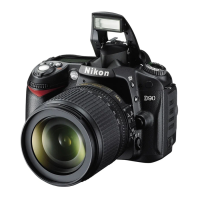1
1
CHAPTER
Exploring the
Nikon D90
T
his chapter covers the key components of the Nikon
D90. These are the features that are most readily acces-
sible because they’re situated on the outside of the camera:
the buttons, knobs, switches, and dials.
If you’re upgrading from another Nikon dSLR, some of this
may seem like review, but there are some new features that
you may or may not be aware of, so a quick read-through is a
good idea even if you’re an experienced Nikon dSLR user.
For those of you who are new to the world of dSLRs, this chap-
ter is a great way to become acquainted with some of the terms
that are used in conjunction with your new camera.
So, let’s explore the D90!
Key Components of the D90
If you’ve read the Quick Tour, you should be pretty familiar
with the buttons and switches that you need for basic set-
tings. In this section, you look at the camera from all sides and
break down the layout so that you know what everything on
the camera’s surface does.
This section doesn’t cover the menus (see Chapter 3), only
the exterior controls. Although there are many features you
can access with just the push of a button, you can usually
change the same setting inside of a menu option. While the
D90 doesn’t have the same amount of buttons as some of its
bigger siblings in the Nikon line, it does have quite a few of
them. Knowing exactly what these buttons do can save you a
lot of time and help you to not miss out on getting a shot.
✦ ✦ ✦ ✦
In This Chapter
Key components of
the D90
The D90 DX CMOS
sensor
Viewfi nder display
Control panel
Shooting Info Display
✦ ✦ ✦ ✦
COPYRIGHTED MATERIAL






